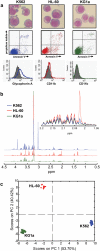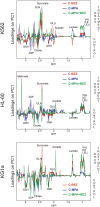Metabolomic profiling of drug responses in acute myeloid leukaemia cell lines
- PMID: 19158949
- PMCID: PMC2621336
- DOI: 10.1371/journal.pone.0004251
Metabolomic profiling of drug responses in acute myeloid leukaemia cell lines
Erratum in
- PLoS One. 2009;4(4). doi: 10.1371/annotation/39584d38-04f5-4b37-bfd8-eae2318ec6f9
Abstract
Combined bezafibrate (BEZ) and medroxyprogesterone acetate (MPA) exert unexpected antileukaemic activities against acute myeloid leukaemia (AML) and these activities are associated with the generation of reactive oxygen species (ROS) within the tumor cells. Although the generation of ROS by these drugs is supported by preceding studies including our own, the interrelationship between the cellular effects of the drugs and ROS generation is not well understood. Here we report the use of NMR metabolomic profiling to further study the effect of BEZ and MPA on three AML cell lines and to shed light on the underlying mechanism of action. For this we focused on drug effects induced during the initial 24 hours of treatment prior to the onset of overt cellular responses and examined these in the context of basal differences in metabolic profiles between the cell lines. Despite their ultimately profound cellular effects, the early changes in metabolic profiles engendered by these drugs were less pronounced than the constitutive metabolic differences between cell types. Nonetheless, drug treatments engendered common metabolic changes, most markedly in the response to the combination of BEZ and MPA. These responses included changes to TCA cycle intermediates consistent with recently identified chemical actions of ROS. Notable amongst these was the conversion of alpha-ketoglutarate to succinate which was recapitulated by the treatment of cell extracts with exogenous hydrogen peroxide. These findings indicate that the actions of combined BEZ and MPA against AML cells are indeed mediated downstream of the generation of ROS rather than some hitherto unsuspected mechanism. Moreover, our findings demonstrate that metabolite profiles represent highly sensitive markers for genomic differences between cells and their responses to external stimuli. This opens new perspectives to use metabolic profiling as a tool to study the rational redeployment of drugs in new disease settings.
Conflict of interest statement
Figures






References
-
- Chong CR, Sullivan DJ. New uses for old drugs. Nature. 2007;448(7154):645–646. - PubMed
-
- Cohen FJ. Macro trends in pharmaceutical innovation. Nat Rev Drug Discov. 2005;4(1):78–84. - PubMed
-
- DiMasi JA, Hansen RW, Grabowski HG. The price of innovation: new estimates of drug development costs. J Health Econ. 2003;22(2):151–185. - PubMed
-
- Bundy JG, Iyer NG, Gentile MS, Hu DE, Kettunen M, et al. Metabolic consequences of p300 gene deletion in human colon cancer cells. Cancer Res. 2006;66(15):7606–7614. - PubMed
Publication types
MeSH terms
Substances
Grants and funding
LinkOut - more resources
Full Text Sources
Other Literature Sources
Medical

